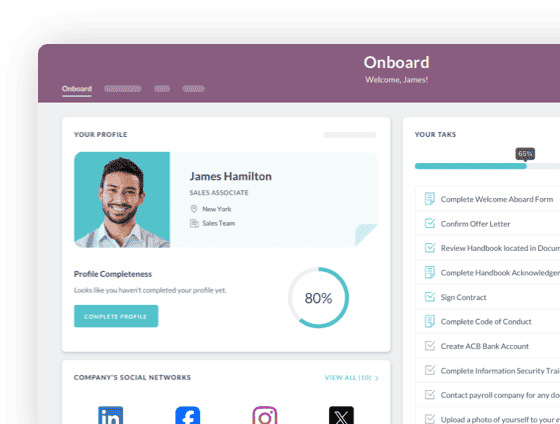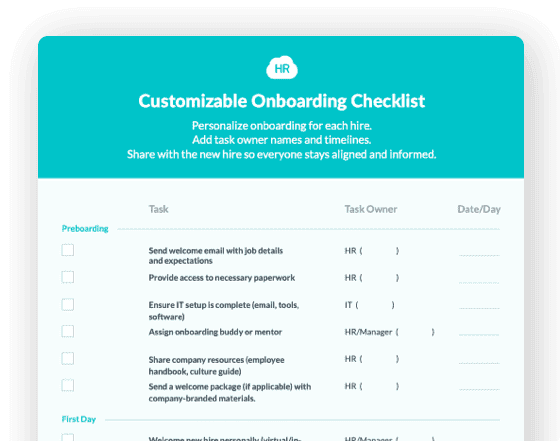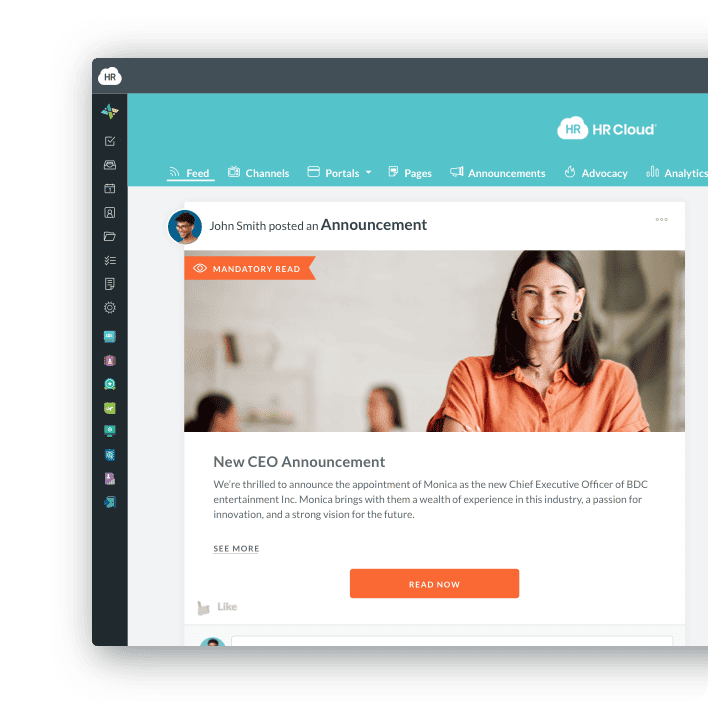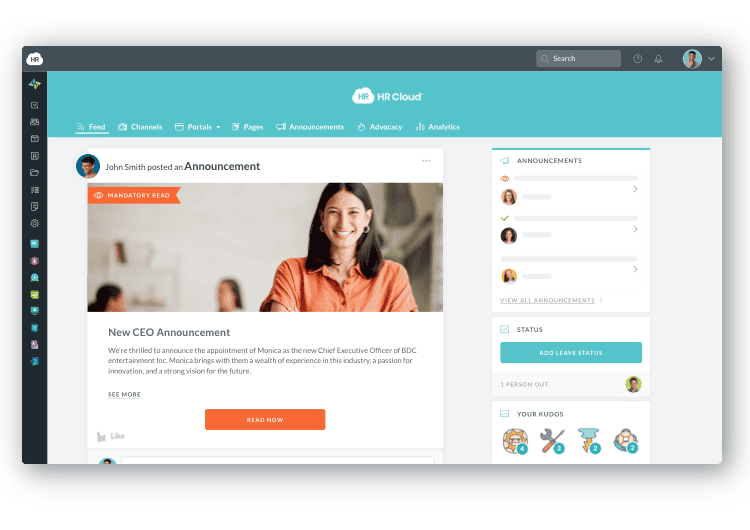Workforce Analytics
- The Core Benefits of People Analytics
- Strategic Workforce Analytics: Driving Business Success with Data
- The Core Benefits of People Analytics
- Comparing Traditional HR Reporting vs. Modern Workforce Analytics
- Best Practices for Successful Workforce Analytics
- Common Pitfalls to Avoid
- Industry Applications of Workforce Analytics
- A Step-by-Step Guide to Implementation
- The Future of Workforce Analytics

 Cut onboarding time
by 60%—here's the
Ultimate Checklist
that helped do it.
Cut onboarding time
by 60%—here's the
Ultimate Checklist
that helped do it.

Workforce analytics is a powerful way for companies to use data. It helps them make smarter decisions about their people. This is more than just counting employees or tracking attendance. This approach involves collecting, analyzing, and applying data. It helps a company understand what drives employee performance, engagement, and retention. By moving past gut feelings, leaders can use workforce analytics to improve how they hire, train, and manage their teams.
This makes companies more efficient and helps them reach their goals. It also helps leaders create a more positive and productive work environment. For example, a retail chain might use workforce analytics to find out which stores have the highest employee turnover. They can then study the data to find out why. Maybe it’s a specific manager’s leadership style or a lack of training for new hires. The key is to use data to pinpoint problems. Then, you can create targeted solutions that actually work.
The Core Benefits of People Analytics
Workforce analytics offers a clear path to understanding your company's most important asset: its people. Using this data can lead to real improvements in how you manage your team and plan for the future. Understanding these benefits is the first step toward building a data-driven HR function.
Improved Talent Acquisition:
Analytics can help you find out which hiring sources bring in the best new employees. This allows you to focus your recruiting efforts and budget on the most effective channels. This helps you find the right people faster and with less effort.
Reduced Employee Turnover:
By analyzing data on why people leave, you can identify patterns. This might show that employees in a certain department are more likely to resign after a year. With this information, you can address the root causes, like offering better career development or adjusting pay. Learning about employee engagement can help you retain your best workers.
Enhanced Employee Development:
Data can reveal skill gaps across your organization. For instance, an analysis might show that many team leaders lack crucial coaching skills. You can then create targeted training programs to address these needs. This helps your employees grow and improves overall performance. Companies can also use data to understand what motivates employees, as discussed in a survey by Gallup.
Boosted Productivity and Performance:
By linking employee data to business results, you can see how different teams are performing. You can find out what makes high-performing teams successful. Then, you can apply those best practices across the company. This helps everyone work smarter.
Strategic Workforce Analytics: Driving Business Success with Data
Workforce analytics is a powerful way for companies to use data. It helps them make smarter decisions about their people. This is more than just counting employees or tracking attendance. This approach involves collecting, analyzing, and applying data. It helps a company understand what drives employee performance, engagement, and retention. By moving past gut feelings, leaders can use workforce analytics to improve how they hire, train, and manage their teams. This makes companies more efficient and helps them reach their goals. It also helps leaders create a more positive and productive work environment. For example, a retail chain might use workforce analytics to find out which stores have the highest employee turnover. They can then study the data to find out why. Maybe it’s a specific manager’s leadership style or a lack of training for new hires. The key is to use data to pinpoint problems. Then, you can create targeted solutions that actually work.
The Core Benefits of People Analytics
Workforce analytics offers a clear path to understanding your company's most important asset: its people. Using this data can lead to real improvements in how you manage your team and plan for the future. Understanding these benefits is the first step toward building a data-driven HR function.
Improved Talent Acquisition:
Analytics can help you find out which hiring sources bring in the best new employees. This allows you to focus your recruiting efforts and budget on the most effective channels. This helps you find the right people faster and with less effort.
Reduced Employee Turnover:
By analyzing data on why people leave, you can identify patterns. This might show that employees in a certain department are more likely to resign after a year. With this information, you can address the root causes, like offering better career development or adjusting pay. Learning about employee engagement can help you retain your best workers.
Enhanced Employee Development:
Data can reveal skill gaps across your organization. For instance, an analysis might show that many team leaders lack crucial coaching skills. You can then create targeted training programs to address these needs. This helps your employees grow and improves overall performance. Companies can also use data to understand what motivates employees, as discussed in a survey by Gallup.
Boosted Productivity and Performance:
By linking employee data to business results, you can see how different teams are performing. You can find out what makes high-performing teams successful. Then, you can apply those best practices across the company. This helps everyone work smarter.
Comparing Traditional HR Reporting vs. Modern Workforce Analytics
|
Feature |
Traditional HR Reporting |
Modern Workforce Analytics |
|
Focus |
Historical, descriptive data (what happened) |
Predictive, prescriptive data (what will happen and what to do) |
|
Examples |
Headcount, turnover rate, time-to-fill |
Retention risk analysis, flight risk scores, talent pipeline health |
|
Purpose |
Compliance, basic reporting |
Strategic decision-making, problem-solving |
|
Question it answers |
"How many people left last quarter?" |
"Who is likely to leave in the next six months and why?" |
|
Output |
Static reports and charts |
Interactive dashboards, actionable insights |
Best Practices for Successful Workforce Analytics
Starting with workforce analytics can seem overwhelming. But a few key practices can make sure your efforts are successful. These tips focus on the practical steps you can take to get the most out of your data.
Start Small and Build Momentum:
Don’t try to solve every problem at once. Begin with one specific business question, like "Why are our new hires leaving so quickly?" This focused approach allows you to prove the value of analytics and gain support from leaders.
Ensure Data Quality and Security:
The insights you get are only as good as the data you use. Make sure your employee data is accurate, complete, and kept secure. This is also important for building trust with your employees.
Partner with Business Leaders:
Don't let analytics live in a silo. Work closely with managers and executives to understand their biggest challenges. By solving a real business problem, you can show them how analytics can help them succeed. This makes the insights more useful and easier to adopt.
Focus on Actionable Insights, Not Just Data:
A colorful dashboard is great, but the real value is in the actions you can take. Your goal is to provide a clear recommendation, like "We should start a mentorship program for new engineers to improve retention." It's about turning data into decisions. Companies can use an employee engagement platform to track key metrics.
Use Visualizations to Tell a Story:
Presenting data in a simple chart or graph can make complex information easy to understand. Visualizations help people see trends and patterns quickly. This makes it easier to get their buy-in and inspire action.


Common Pitfalls to Avoid
With any new initiative, there are common mistakes that can derail a workforce analytics project. Being aware of these pitfalls can help you avoid them and get real results.
Ignoring the "Why":
Don't just report numbers without understanding the context. A high turnover rate is a problem, but the real question is why it's happening. A good analytics project seeks to answer the underlying reason for the data.
Getting Lost in the Data:
It's easy to get overwhelmed by the sheer volume of data. Focus on what is most important for your business. Stick to the key metrics that directly support your goals, such as employee retention or new hire performance.
Lack of Leadership Buy-In:
If leaders don't believe in the value of analytics, the project will likely fail. You need to show them how data can help them solve their biggest problems and achieve their strategic goals.
Treating Employees Like Numbers:
The goal of workforce analytics is to improve the employee experience. It's not just about tracking people. It's crucial to be transparent about what data you collect and how you use it. This builds trust and shows that you care about your employees as individuals.
Forgetting to Act on the Insights:
The most common mistake is collecting a lot of great data and then doing nothing with it. The insights are only valuable if they lead to action. Make sure you have a plan for how to implement changes based on what the data tells you. This is where the real value of data analytics comes from.
Industry Applications of Workforce Analytics
Workforce analytics is being used in many industries to solve unique problems. Here are a few examples of how companies are applying these principles to their specific challenges. You can find more information about these applications by looking at talent management solutions.
Retail:
A large retail chain might analyze sales performance data with employee schedules. They might discover that stores with certain scheduling patterns have higher customer satisfaction and sales. This could lead to a new scheduling policy that boosts profits. The company could also use data to identify and support high-performing store managers. A case study from Harvard Business Review highlights how analytics can improve organizational performance.
Technology:
A tech company might use analytics to understand why their top engineers are leaving. They could find that these employees leave when they stop working on challenging projects. The company can then create a new process to ensure top talent is always assigned to their most important and engaging work.
Healthcare:
A hospital system could use workforce analytics to find factors that lead to nurse burnout. By studying scheduling, patient-to-nurse ratios, and training data, they might discover that nurses who work more than three nights in a row have a higher risk of burnout. This could lead to new scheduling rules that improve nurse well-being and patient care. The right data can help improve employee performance. A report from the World Economic Forum emphasizes the importance of a skilled workforce.
A Step-by-Step Guide to Implementation
Starting a workforce analytics program doesn’t have to be a major overhaul. You can start with a simple plan and build from there. Here is a practical, step-by-step approach to get your program off the ground.
Define Your Business Questions:
Don't start with the data. Start with a problem. What is the biggest challenge your leaders face? Is it high turnover? Low employee engagement? Not finding the right people? Answering this question helps you focus on what really matters. This is the foundation of any successful workforce analytics initiative.
Identify and Collect Your Data:
Once you have your question, figure out what data you need to answer it. This might include information from your HR system, performance reviews, employee surveys, and even data from your business operations. A modern HR cloud platform can make it much easier to collect and organize this data.
Choose Your Tools:
You don't need a huge budget to start. You can begin with a simple spreadsheet and move to more advanced software as you grow. A good HR analytics platform can automate many of the steps and help you create professional reports and dashboards. An HRIS system can be a good starting point for your data.
Analyze the Data:
This is where you look for patterns and connections. A common mistake is just to look at the numbers. Instead, you need to understand what the numbers mean. For example, you might see that a certain team has low morale. The next step is to find out why.
Generate and Share Insights:
Turn your analysis into a clear and compelling story. Use charts and graphs to make your findings easy to understand. Present your recommendations to leaders and explain how these actions will solve a specific business problem. Providing a dashboard for your leaders is a great way to show them the data in an easy-to-understand format.
Take Action and Measure Results:
The final step is to act on your recommendations. If you suggest a new training program, launch it. Then, continue to measure the results. Did the training improve performance? Did turnover decrease? This feedback loop shows the value of your work. It also helps you fine-tune your approach for the future.
The Future of Workforce Analytics
The field of workforce analytics is evolving quickly. As technology improves, we are seeing new trends that will change how companies think about their people. Being aware of these developments can help you prepare for what's next.
Increased Focus on Ethical AI:
As companies use artificial intelligence to analyze employee data, there will be a greater need for ethical guidelines. It will be crucial to ensure that algorithms are fair and don't introduce bias into hiring or promotion decisions. This will become an even more important part of the conversation around managing human capital.
Predictive and Prescriptive Analytics:
The shift from understanding the past to predicting the future is already happening. Soon, analytics will not only tell you who is likely to leave but also recommend the exact steps you can take to keep them. This is the next frontier of data-driven human resources. According to a Forbes article, this shift is already underway.
Integrating with Business Data:
The future of workforce analytics involves connecting people data with sales, customer, and financial data. This will allow companies to prove the direct link between a great employee experience and improved business performance. For example, showing how an improved onboarding process leads to higher sales numbers.
Real-Time Insights:
The speed of business is increasing, and so is the need for real-time data. Soon, leaders will have access to live dashboards that show them the health of their teams at any moment. This will allow for proactive decision-making rather than reactive problem-solving. A focus on employee engagement is a key driver for this trend.
By embracing these trends, companies can stay ahead of the curve. They can make sure their most important asset—their people—is working at its full potential. The future of work is not just about technology. It's about using that technology to empower and support the people who make a business successful.
Keep Reading
From Manual to Automated: A Complete Guide to Digitizing Employee Onboarding for Large Organizations
Sarah Chen, Director of HR at a 7,000-employee healthcare organization, starts her Monday
Enterprise HR Software in 2025: Why Traditional Enterprise Platforms Fall Short and What Actually Works
Traditional enterprise human resources software systems promise comprehensive solutions
AI in Onboarding: Complete Guide for 2026
You’ve probably been hearing this multiple times a day — AI is transforming HR. But
Ready to streamline your onboarding process?
Book a demo today and see how HR Cloud can help you create an exceptional experience for your new employees.

